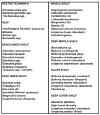About This Item
- Full text of this item is not available.
- Abstract PDFAbstract PDF(no subscription required)
Share This Item
The AAPG/Datapages Combined Publications Database
GCAGS Transactions
Abstract
ABSTRACT: Local Biostratigraphic Markers of the Frio (Oligocene), Northern Mustang Island, Texas State Waters
ABSTRACT
The Frio Formation of the northern Mustang Island Texas State waters area was deposited in an active growth-faulted basin on the flanks of the Norias delta system. Biostratigraphic analysis of several recently drilled wells and reinterpretation of older biostratigraphic well reports (Fig. 1) suggest that several local biostratigraphic markers may be more reliably used in conjunction with well log and seismic correlations than the more recognized regional datums (Fig. 2). Older biostratigraphic reports usually recognize only two regional markers, Marginulina texana and Bolivina mexicana. Ecologically, Marginulina texana is most reliable updip (inner to middle neritic), whereas Bolivina mexicana is limited to outer neritic or deeper environments.
Within the expanded Marginulina texana section, several local foraminiferal events are useful for enhanced correlation (Breard et al., 1996). Two closely-spaced extinctions or last appearance datum (LADs), Nonion 2 and Eponides vicksburgensis, possibly representing a condensed zone, are correlative with a transgressive sand that ties to a strong seismic event mappable throughout the study area. Another marker, Discorbis E, is correlative between the updip wells and may constrain the Bolivina mexicana equivalent section in environments too shallow to support that marker.
The lower expanded Marginulina texana or Bolivina mexicana sands become progressively shallower through deltaic influence, resulting in lower faunal diversityand fewer correlatable assemblages (Fig. 3). Several acmes of Cibicides hazzardi and a zone of common Textularia spp. appear correlative within the deltaic sands. This study illustrates the value of local foraminiferal events for correlation of expanded stratigraphic sections along depositional strike.
End_Page 919------------------------
 Figure 1. Location map--northern Mustang Island. From Seni et al. (1997)
Figure 1. Location map--northern Mustang Island. From Seni et al. (1997)
End_Page 920------------------------
 Figure 2. Local biostratigraphic chart, Upper Frio (Oligocene), northern Mustang Island area, Texas State Waters.
Figure 2. Local biostratigraphic chart, Upper Frio (Oligocene), northern Mustang Island area, Texas State Waters.
 Figure 3. Observed foraminiferal environmental indicator taxa, Upper Frio (Oligocene), northern Mustang Island area, Texas State Waters.
Figure 3. Observed foraminiferal environmental indicator taxa, Upper Frio (Oligocene), northern Mustang Island area, Texas State Waters.
End_Page 921------------------------
REFERENCES
Breard, S.Q., A.D. Callender, and M.J. Nault, 1996, Local foraminiferal faunas: the key to enhanced stratigraphic resolution of expanded Cenozoic sections in the Gulf Coast Basin: Gulf Coast Association of Geological Societies Transactions, v. 46, p. 55-62.
Seni, S.J., T.F. Hentz, W.R. Kaiser, and E.G. Wermund, Jr., 1997, Atlas of Northern Gulf of Mexico Gas and Oil Reservoirs, v.1, Miocene and Older Reservoirs: Bureau of Economic Geology, University of Texas at Austin, 199 pp.
End_of_Record - Last_Page 922-------
ACKNOWLEDGMENTS AND ASSOCIATED FOOTNOTES
1Osprey Petroleum, Houston, Texas
2Applied Biostratigraphix, Houston, Texas
The authors thank Gary Penley and his co-workers at Unocal, for their encouragement and support as Osprey's drilling partner in the northern Mustang Island state waters.
Copyright © 2003 by The Gulf Coast Association of Geological Societies
